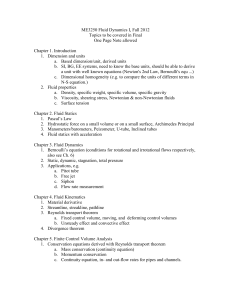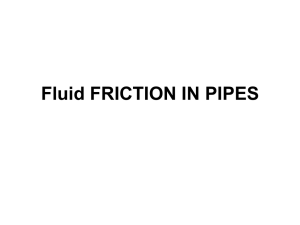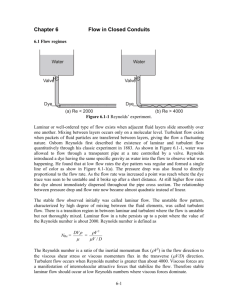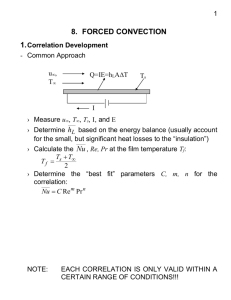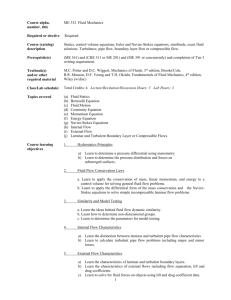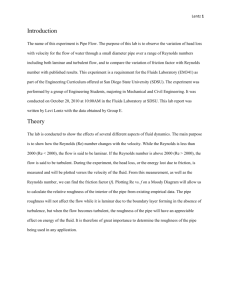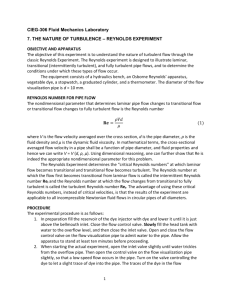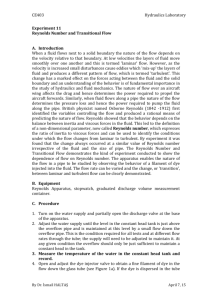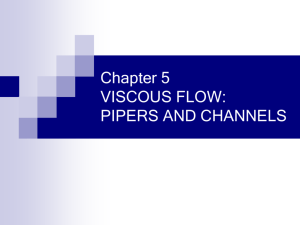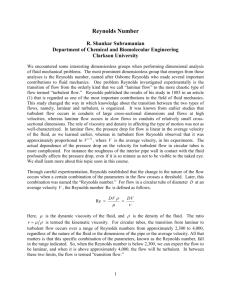Reynolds Apparatus Design & Construction Project Report
advertisement
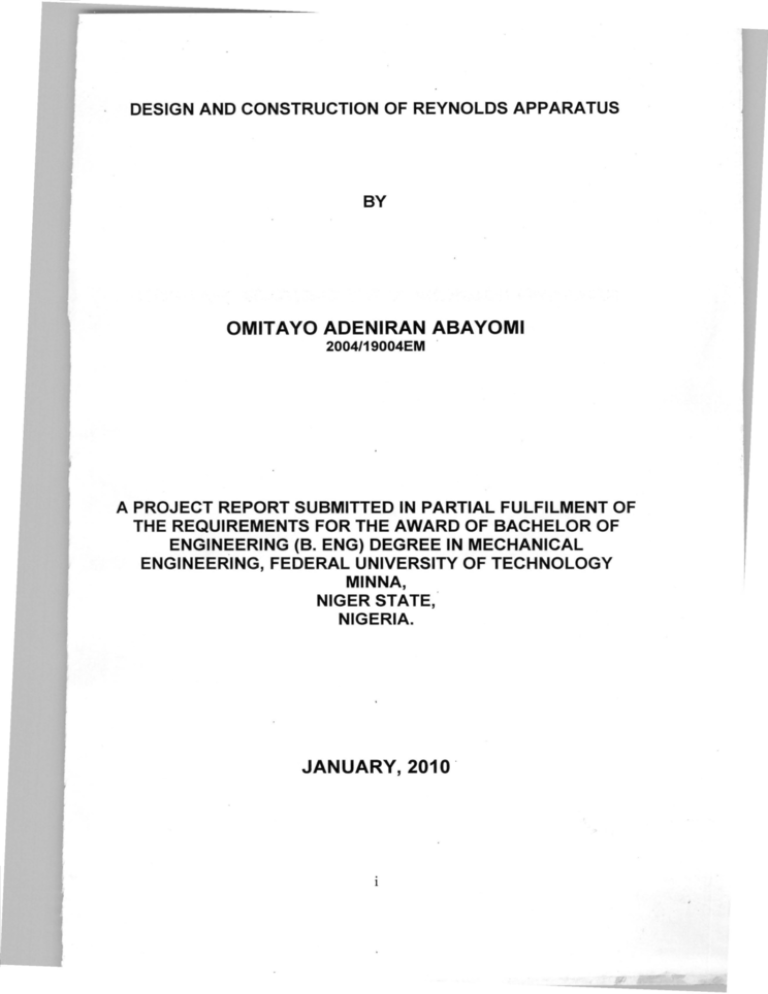
DESIGN AND CONSTRUCTION OF REYNOLDS APPARATUS
BY
OMITAYO ADENIRAN ABAYOMI
2004/19004EM .
A PROJECT REPORT SUBMITTED IN PARTIAL FULFILMENT OF
THE REQUIREMENTS FOR THE AWARD OF BACHELOR OF
ENGINEERING (B. ENG) DEGREE IN MECHANICAL
ENGINEERING, FEDERAL UNIVERSITY OF TECHNOLOGY
MINNA,
NIGER STATE,
NIGERIA.
JANUARY, 2010 ·
DECLARATION
I hereby declare that this project presented is partial fulfillment for the requirement of the
award of bachelor of engineering (B.Eng) degree has not been presented before other
wholly or partially for any other degree elsewhere, information hereby obtained from
published work of others are acknowledged accordingly.
Date
Student Signature
n.'.
DEDICATION
I dedicate this report to my beloved late mother Mrs. F.A Omitayo, my understandable
friends and also my father Chief E.A Omitayo.
IV
ACKNOWLEDGEMENT
I want to thank the almighty God that made it possible to start the programme and end it
successfully, May He reigns forever.
Also nly gratitude goes to my father Chief E.A Omitayo, my brothers and sisters, Engr.
& Arc (Mrs) A.A.A Omitayo, Mr. Adesheye Omitayo, Engr. A.K Omitayo, Miss
Adekemi Omitayo, Miss Adekunbi Omitayo, Ayobami Shittu, my friends and loved ones.
I cannot forget but to appreciate my aunty for her supports Chief (Mrs.) E.l Oluwa, Engr.
S.A Ayo and M S Lee with his enthuse supports.
1 am indeed grateful
DESIGN AND CONSTRUCTION OF REYNOLDS A PARATUS
OMITf'-.YO ADENIRAN A
2004/19004EM
.
BAYOMI
DEPARTMENT OF ME
ENGINEERING AND E~~~:~~~L ENGINEERING, S HOOl
UNIVERSITY OF
TEd~~~CgHNOLOGY. FEDE~~
NIGER STATE GY MINNA,
NIGERIA
'
TABLE OF CONTENT
DECLARATION ............................................................................................................... ii
CERTIFICATION ... ~ ........................................................................................................ ii
DEDICATION.................................................................................................................. iii
ACKNOWLEDGEMENT ................................................................................................ v
ABSTRACT ...................................................................................................................... VI
CHAPTER ONE ............................................................................................................... 1
INTRODUC TION ........................................................................................ ..................... 1
1.l Background of Study ........................ ·.. ·...
................................................................... 1
............................................................................. 4
1.2 Aims of the Study ........ ·· ......·..........
4
1.3 Scope .nd Limit.tion of Study................................................................................... 5
................................................................................................... 6
1.4 Significance of Study
CHAPT
...............................................................
ER TWO ...............................
·1.1IE~
,Y
................
................
6
.. ......................... .
....................................................
...............
6
TURE RE
....................................... .
LITERA
..........
8
.
ackground ......... ····· .. ·.. ··· .. ·······
.......................... .
2.1 \listoflc• 1B
App.r. .......................... ···················............. ...................... 8
tus
2.1 Existing Reynolds
..............................................................
9
2.2.1 OsbOrn• ReynoldS .........:.::.•.................•........................,.............".................. '.':.':.:' 10
'{ ecbnolotp,Y ...,
2.2.2
C:::::
ld
Osborne
...............................•...........................,.
lleynol~~.::::::::::...•...........................................................::::::.. 11
2:':4 D.niel Lorst.d········~~::~ition in a Strai~t
p
or~
~f,
c~Y1\t\t1\\'
........ .
1:
.. ............ 4
yip· ......::::::::::::::::::::::::::::::..........
su\ts on
...................
Gertera\ re
A. nn"'r atuS .........
............ ..
1.1.;;J
ne~no\dS t'-rr"
........................ .
\t' on ~ 'J
•••••••••••••
.....
"t""
...........
.
" :3 yr ese
............
~
~.
11
PROJECT DESIGN ........................................................................................................ 14
3.1 Design Description .................................................................................................... 14
3.2 Mode of Operation .................................................................................................... 17
3.2.1 Maintenance Operation ..................................................................................... 18
3.3 Design Analysis .......................................·................................................................... 20
3.3.1 Frictional Head Loss in pipe ............................................................................. 23
3.3.2 Frictional Head for Laminar Flow ..................... ~ ............................................. 24
3.3.3 Frictional Head for Turbulent Flow ................................................................ 27
3.4 Design Calculation .................................................................................................... 30
3.4.1 Calculation for Laminar.................................................................................... 30
3.4.2 Calculation for transition .................................................................................. 31
3.4.3 Calculation for turbulent .................................................................................. 31
3.5 Design Specification .............................. :................................................................... 32
3.6 Construction or Fabrication .................................................................................... 33
3.6.1 Material selection ............................................................................................... 33
3.6.2 Construction Technique .................................................................................... 33
3.6.2.1 Glass Tank ................................................................................................... 33
3.6.2.2 Apparatus Cart ........................................................................................... 34
CHAPTER FOUR ........................................................................................................... 35
PERFORMANCE TESTING AND COST ANALYSIS ............................................. 35
4.1 Performance Testing ................................................................................................. 35
4.2 Discussion of Result ................................................................................................... 35
4.2.1 Laminar flow ...................................................................................................... 35
Vlll
4.2.2 Transitional Flow ............................................................................................... 36
4.2.3 Turbulent flow .................................................................................................... 37
4.3 Cost Analysis ............................................................................................................. 38
4.3.1 Direct Cost ...................................... :................................................................... 38
4.3.1.1 Material Cost ............................................................................................... 39
4.3.1.2 Labour cost .................................................................................................. 40
4.3.2 Overhead Cost .................................................................................................... 40
.
CHAPTER FIVE ............................................................................................................ 41
CONCLUSION AND RECOMMENDATION ............................................................ 41
5.1 Conclusion ................................................................................................................. 41
5.2 Recommendation ....................................................................................................... 42
REFERENCES ................................................................................................................ 43
IX
CHAPTER ONE
INTRODUCTION
1.1 Background of Study
"
All students of the engineering are aware of the Number and equation associated
with Reynolds. The former (Number) is a dimensionless group ( Re
~ v~p). where Re
is the Reynolds number, V is the velocity, D is the pipe diameter, p is the density, Il is the
dynamic viscosity, which is related to the transition between laminar and turbulent flow,
the latter (equation) is a cornerstone of the mathematical description of fluids in motion.
The effect was demonstrated by Reynolds by injecting a thin trace of ink (dye) into water
flowing along a glass pipe in tank; by varying the diameter of the pipe and the velocity of
the water in the tube. Reynolds develop a relationship between these quantities and the
viscosity which governs the laminar or turbulent switch (transition point), which an
illustration of this switch can be easily accessible by a layman when experimented prior
to the knowledge necessary of student to tackle the subject areas of compressible and
incompressible flows (Jackson, 1995). However, when a body is immersed in a fluid and
is in relative motion a drag is produce which is define as that component of the relative
force acing on the body which is in the direction of the relative motion. Thus, in external
flow, the immersed body is subjected to frictional rag over its entire surface. Total drag
on the body often called profile drag is there made up of two components namely
.'
pressure (form) drag which depends on the pressure anq skin friction drag which depends
on the shear force. Therefore, the higher the velocity the higher the drag (turbulence) with
the heat produced and the lower the velocity the lower the drag (laminar).
The study of a fluid at rest or in relative motiOil can be simplified by the absence
or presence of shear forces respectively, but then a fluid flows over a solid surface or
other boundary whether stationary or moving, the velocity of the fluid in contact with the
boundary must be the same as that of the boundary and a velocity gradient is created at
right angles to the boundary, that is when a real or ideal fluid flow comes in.
The resulting change of velocity from layer to layer of fluid flowing parallel to the
boundary gives rise to shear stresses in the fluid which is called fluid flow, the individual
particles of fluid move as a result of the action of forces set up by differences of pressure
or elevation. Their motion is controlled by its inertia and the effect of the shear stresses
exerted by the surrounding fluid.
However, conditions in a body of fluid can vary form point to point and at any given
-
'- "''''xt which now describe whether a flow is uniform and non-
This is to eertifi J
CERTtF/CA nON
y t Jat this
.
Was
.
project titled d .
earned Out b
eSlgn and
OMITA YO AD
construction orR
S.A A
EN/RAN
eYnold A
yo and Submitt d .
ABA YOM/
s Pparatus
,
e Lo the M
under the
Ot Techno/o.
echanical En :
.
supervision ofE
gy, MInna .
gmeenng D
ngr.
of
' I1J Partial fi I
epartment F
Engineeri
U filJment fi.
' <ederal U .
ng (B. Eng) d
or the requir
nlversity
egree in M
ement of h
eehanieal
t e aWard of b
y
.
a~~w
----
"IJgr. S A A
-Project Su
-:0
pervlSO r
Date
•
Steady non-uniform flow: Conditions change from point to point but not with
time. The velocity and cross-sectional area of the stream may vary from crosssection to cross-section, but for each cross-section, they will not vary with time;
for example, flow of a liquid at a constant rate through a tapering pipe running
completely full.
•
Unsteady uniform flow: At a given instant of time the velocity at every point is
the same, but this velocity will change with time; for example, accelerating flow
of a liquid through a pipe of uniform bore running full, such as would occur when
a pump is started up.
•
Unsteady non-uniform flow: The cross-sectional area and velocity vary from
point to point and also change with time; for
~xample ,
a wave traveling along a
channel.
The resulting motion is not easily analyzed mathematically and it is often necessary to
supplement theory by experiment that is when Osborne Reynolds performed a series of
correlations in 1883 based, on the equipment or instrument called Reynolds apparatus,
which showed that two entirely different incompressible fluid flow exist which are
laminar flow (Re < 2000) and turbulent flow (Re > 2000).
Nevertheless, for laminar flow to occur depends on low speeds, small diameters, low
densities and high viscosities, while turbulent flows occur for the opposite conditions:
high speeds, large diameters, high densities and low viscosities (Douglas et aI, 1998).
3
1.2 Aims of the Study
Reynolds number is a very useful dimensionless quantity (the rate of dynamic
forces to viscous forces) that aids in classifying certain flows. For incompressible flow in
a pipe, Reynolds number based on the pipe diameter Re= VDp/1l serves well.
Nevertheless, the aim of the study is to provide a means of appreciating the
concept of Reynolds number and demonstrating the yarious regimes of fluid flow in a
pipe that is, laminar, transitional and turbulent flows.
Maximizing locally sourced material, · employing simplified and economically
feasible production techniques in the production of Reynolds apparatus.
Driving the local p~oduction of this vital engineering equipment and reducing the
rate of importation of Reynolds apparatus.
1.3 Scope and Limitation of Study
The scope of the fabricated apparatus shall be· limited in the laboratory to the
illustration of laminar, transitional and turbulent flows in pipes which however will be
demonstrated with an ink (dye) injected in a transparent observation tube which is made
up of glass for aesthetics and good surface finishing.
Generally, laminar flows correspond to Re<21 00, transitional occurs in a range of
2100<Re<4000 and turbulent flows exist for Re>4000, therefore, limitation of apparatus
can come from the disturbances of flow from different sources (humidity, fluid viscosity,
knocking of the table) may cause the flow to deviate from this pattern. Cost and
availability of materials also added to the limitations to the study.
4

